2007 VOLKSWAGEN GOLF PLUS ABS
[x] Cancel search: ABSPage 70 of 541
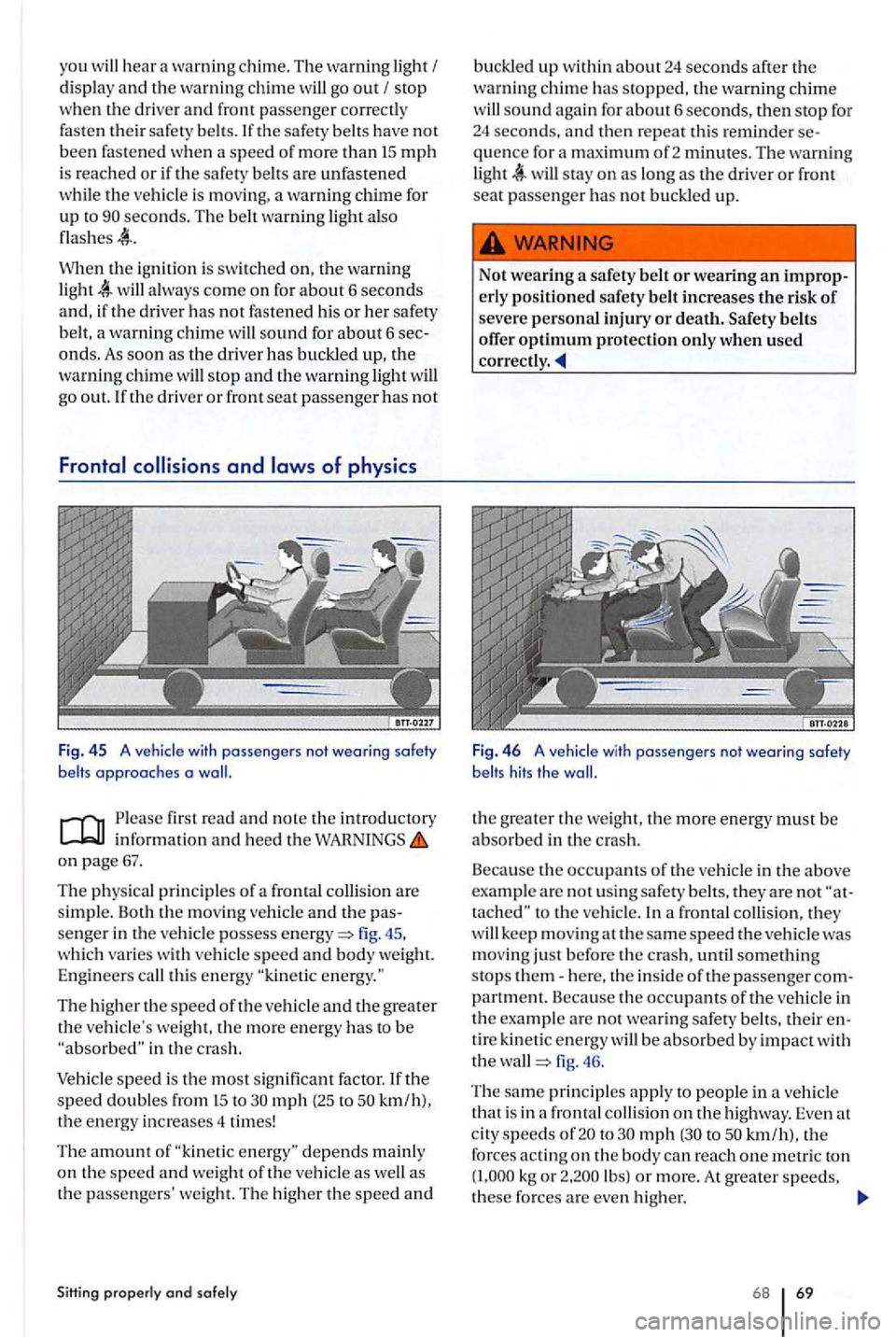
you hear a warn ing chime. The warning light stop
when the driver and front passenger correctly fas ten their sa fety belts. If the safety belts have not been fastened when a speed of more than 15 mph is reached or if the safety be lts are unfastened
while the vehicle is moving , a warning chime for
up to seco nds. The belt warning light also
When the ignition is sw itched on, the warning
and of phy sic s
Fig. 4 5 A vehicle with passengers not wearing safety belts approaches a
on page 67.
The physical principles of a frontal
fig . 45.
which varies wit h vehicle speed and body weight.
Engineer s
The higher the speed of the ve hicle and the greater
the vehicle's weight. the more en ergy has to be in the cras h.
Vehicle speed i s th e most sig nificant factor. If the speed doubl es from to mph (25 to kmlh),
the energy increases 4 times!
The amount of as
the passengers' weight. The higher the speed an d
Sitting properly and solely
buckled up within about24 seconds after the
warn ing chim e has stopped, the warnin g chime sound again for about 6 seco nds, then stop for 24 seconds, and then rep eat this reminder sequence for a
Fig. 4 6 A vehicle with passengers not wearing safety
belts hits the
the greater the we ig ht, the more energy must be abso rbed in the crash.
Beca use the occupants of th e vehicle in the above
example a re not usi ng safety belts, they are not
kee p m oving at the same speed the vehicle was
mo vin g just before the crash, until somethin g
stops th em-here, the inside of the passenger com
partment. Because the occupants of the vehicle in
th e exa mpl e are not wearing safety belt s, th eir en
tire kine
tic energy be absorbed by impact with
the fig. 46.
Th e
same pri ncipl es app ly to p eople in a veh icle
th at is in a fron ta l
to mph to kmlh), the forces acting on th e bod y can reach one metri c ton kg o r lbs) or more. At grea te r speeds,
th ese forces are even hi ghe r.
68 69
Page 89 of 541
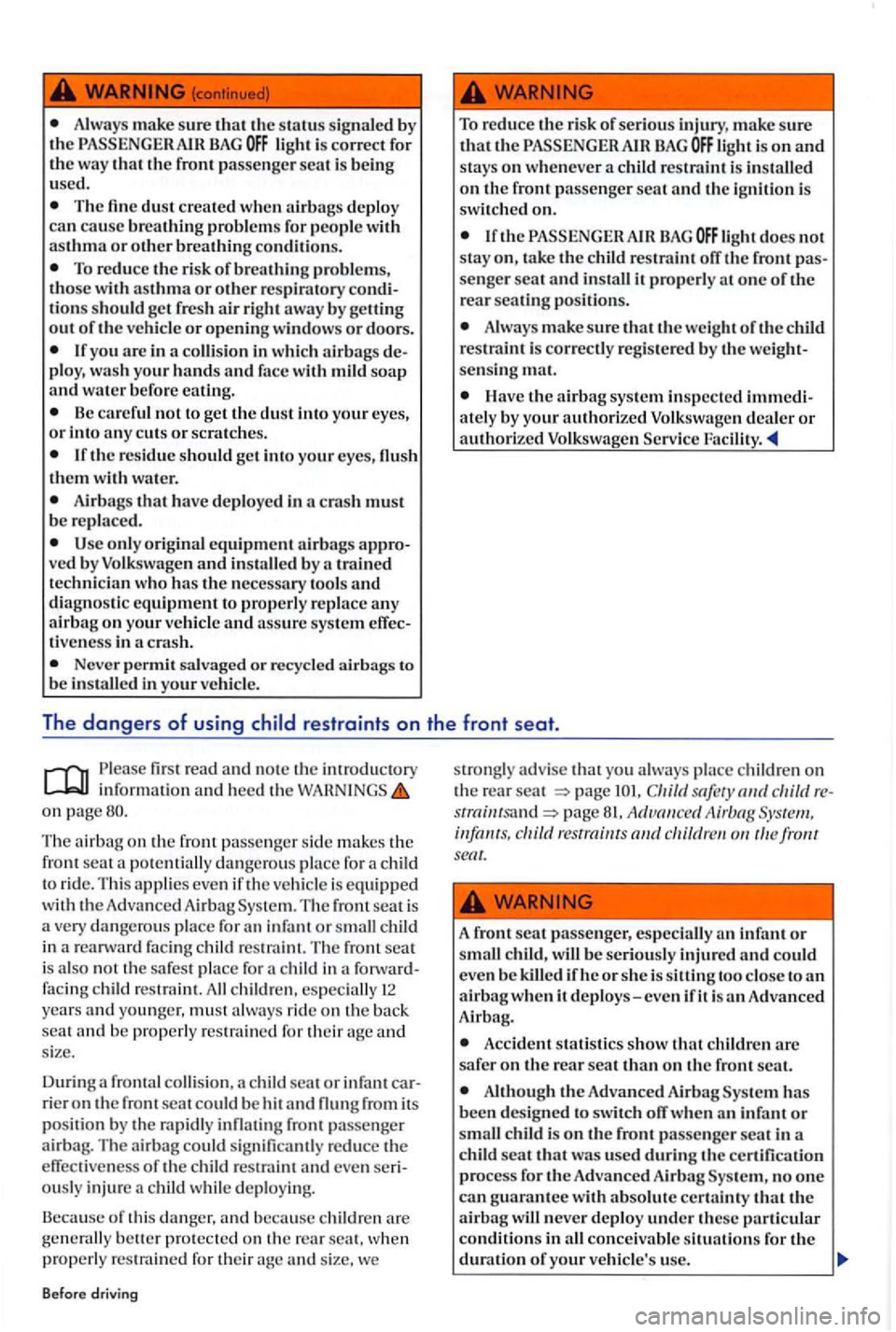
Always make sure that the s tatus s ig nal ed by
th e
The fin e du st create d wh en airbags deploy can cause breathing probl em s fo r people asthma o r o th er breathing co nditi on s.
To reduce the ris k of breathing pro blem s,
t h ose with asthma or other r es pirato ry condi
tions s h o ul d get fr es h air right away by gettin g out of the vehicl e or ope nin g wind ow s or doors.
yo u a re in a an d face w ith mild soap and water befor e eating.
Be not to ge t th e du st into your eyes , or into any cuts o r sc rat ches.
Airba gs that have de plo yed in a c rash mus t
b e re pla ced.
a train ed
t ec hni cian who has the necessary tools
Neve r permit salv a ge d or r ecy cled airbags to
b e in sta ll ed in your ve hicle.
To reduc e the ri sk of seriou s injury, make s ure
th at
child restraint is in stalle d on th e front passe nge r scat and th e ig nition is
s wit ch ed on.
th e light docs not sta y on, ta ke senger seat a n d in stall it pro pe rl y at o ne o f
Always make sure
racilit y
The dangers of using
first r ead and not e th e in troductory inf o rma tio n a nd hee d th e on p age
Th e a irbag on th e front passe ng er side m ake s th e
f ron t se at
ye ars an d yo ung er, must a lways ride o n th e back sea t and be properly re s trai ned for their a nd
s ize .
D urin g a
collisio n. a child scat o r i nfant hi t and flung from it s
posi tion by th e rapid ly infl atin g front passenger
a ir b ag. The a irbag could sig nifica ntly re d uce th e
eff ect ive ness of th e c hild res tra int and even seriously injure
bette r pro te c te d o n th e rear seat , w hen
prop erly res trai ned fo r th eir age a nd size , w e
Be fore driving
str ong ly adv ise that you alw ays pla ce chi ld re n on
th e rea r seat snfety child
child se n t.
A front seat passe nger, es peciall y an infant or
s m all child , will be seriously injure d and could
eve n be kill ed if he or she is s ittin g too close to an a irb ag whe n it deploys-e ven if
Accident stati sti cs show that c hildr en arc safe r on the rear seat than on th e fr ont seat.
Alth oug h th e A dvance d Alrbag or child is on front passenger seat in a
c hil d scat that was used during th e certificatio n process fo r th e A dvanced Airbag no one
can g u arantee with abso lut e ce rtaint y that the airbag will neve r deploy under th ese parti cular condition s in all conceivable situ ation s for the dura tio n of your vehicl e's usc.
Page 93 of 541
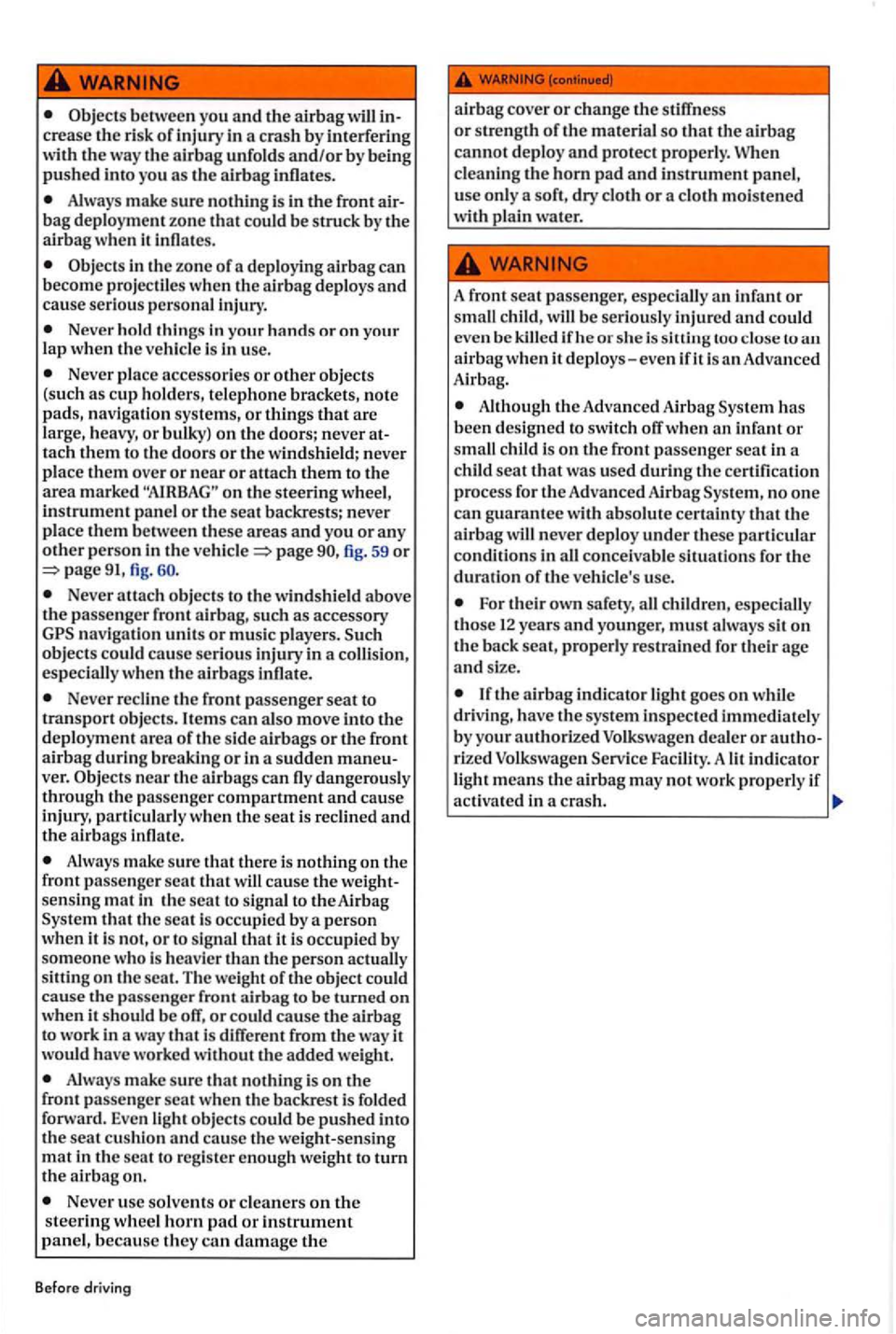
Always make sure nothing is in the front airbag deploym ent zone that could be struck by the airbag when it inflates.
Never hold things or on your lap when the vehicle is in use.
Never place accesso ries or other objects
(such as cup holders, tel ephone brackets, note pads, navigation systems, or things that are large, heavy, or bulky) on the doors; never attach them to the doors or the windshield; never place th em over or near or attach them to the area marked
fig. 59 or 91, fig.
Never attach objects to the windshield above the passenger front airbag, such as accessory navigation units or music player s.
Never recline th e front passenger seat to transport objects. can also move into the deployment area of the side airbags or the front airbag during breaking or in a sudden maneuver. near th e a irbags can fly dangerously through the pass enger compartment and cause injury, particularly when the seat is reclined and the airbags inflate.
Always make sure that there is nothing on the front passe nger seat that will cause the weightsensing mat in the scat to signal to theAirbag that the scat is occupied by a person when it i s not, or to signal that it is occupied by someone who is heav ie r than the person actually
sitting on th e sca t. The weight of th e object could cause the passenger front airbag to be turned on when it should be off, or could cause the airbag to work in a way that is differ ent from the way it
would have worked without the added weight.
Alwa ys make sure that nothing is on the front passenger seat when the backrest is folded
forward. Even light objec ts could be pushed into the seat cu shi on and cause th e weight-sensing mat in the seat to re gister enough weight to turn the airbag on.
Never usc solvents or cleaners on the steering wheel horn pad or instrument panel, because they can damage the
Before driving
airbag cover or change the stiffne ss or strength of the material so that the airbag cannot deploy and protect properly. When cleaning the hom pad and instrumen t p anel, use only a soft, dry cloth or a cloth moist en ed
with plain water.
A front seat passenger, especially an infant or small child, will be seriously injured and could
eve n be killed if he or she is
Although the Advanced Airbag has been designed to switch off when an infant or child is on the front passenger seat in a child seat that was used during the certification
process for the Advanced Airbag no one can guarantee with absolute certainty that the airbag never deploy under these particular conditions in all conceivable situations for the duration of the vehicle 's use.
For their own safety, all children, especially those 12 years and younger, mus t always sit on the back seat, properly restrained for their age and size.
Facility. A lit indicator light means the airbag may not work properly if
activated in a crash.
Page 140 of 541

Driving with an open rear hatch
P lease read and not e the introd uctory information and hee d the on pag e 137.
Driv in g w ith an open rear hatch ca n lead to seriou s
perso nal injury. I f yo u have to drive w ith an op en
rear h a tch, make sure that objects an d th e hatch itse lf are properly secured and take appropria te
m easures to keep tox ic exhaust fumes from te rin g th e vehicle .
Driving w
itJ1 an unlatc hed o r open rear hatch
ca n l ead to seriou s pe rso nal injury.
Always driv e witJ1 the rear hatch closed to
h elp kee p poisonou s ex hau st gas from being
drawn into the ve hicle.
Never transport objec ts lar ger than those fittin g co mpletely int o the lu ggage area, beca use then the rear hatch cannot be full y clo sed.
Always stow all objects secu re ly in the
Dr ive care fully; a ntic ipat e what otJ1er driver s will do.
Avoid abrupt o r sudden driv in g or braking maneuv ers, as unla tch ed rear hatch can move suddenly .
A lways mark obje cts sti cking out from the lu ggage compartment clear ly for others to see .
Ob e applicabl e req uirements.
Transporting
Neve r u se the rear ha tc h t o or ob jec ts protruding from the luggage ment.
Alway s remove any lugga ge rack or other
rack mounte d on tJ1e rea r hatch (along with an y
l uggage on th e rack) befor e driving with an ope n
r ea r h atch .
Driving w
ith an open rear hatch can cause sonous carbon mon oxide in the en g in e exhaust
to get into the passe nger compartment.
monoxide cau ses drow sin ess,
inatt enti veness , poison ing , and loss of scio u snes s. can lead to accid ents and seve re
perso na l in juri es.
Always kee p th e rear hat ch closed whil e
driving to help keep poi sonous exha ust fum es
from b ein g drawn into the ve hicl e.
Neve r tran sport obj ec ts that are to o large
t o fit completely int o the lu ggage area, beca use
th en the rear hatch cannot be full y closed.
yo u abso lutely mus t driv e w ith open rea r h atch, do th e
all windows and the powe r sunro of.
- Switc h off the climat e
control sys te m's a ir
recirculation feature.
-
Open all air vents in the in strument pa nel.
- Se t th e fres h air fa n t o th e hi ghest speed.
Note
T he ope n rear hatc h ch anges th e ve hicle's lengt h and he ight .
138 139
Page 154 of 541
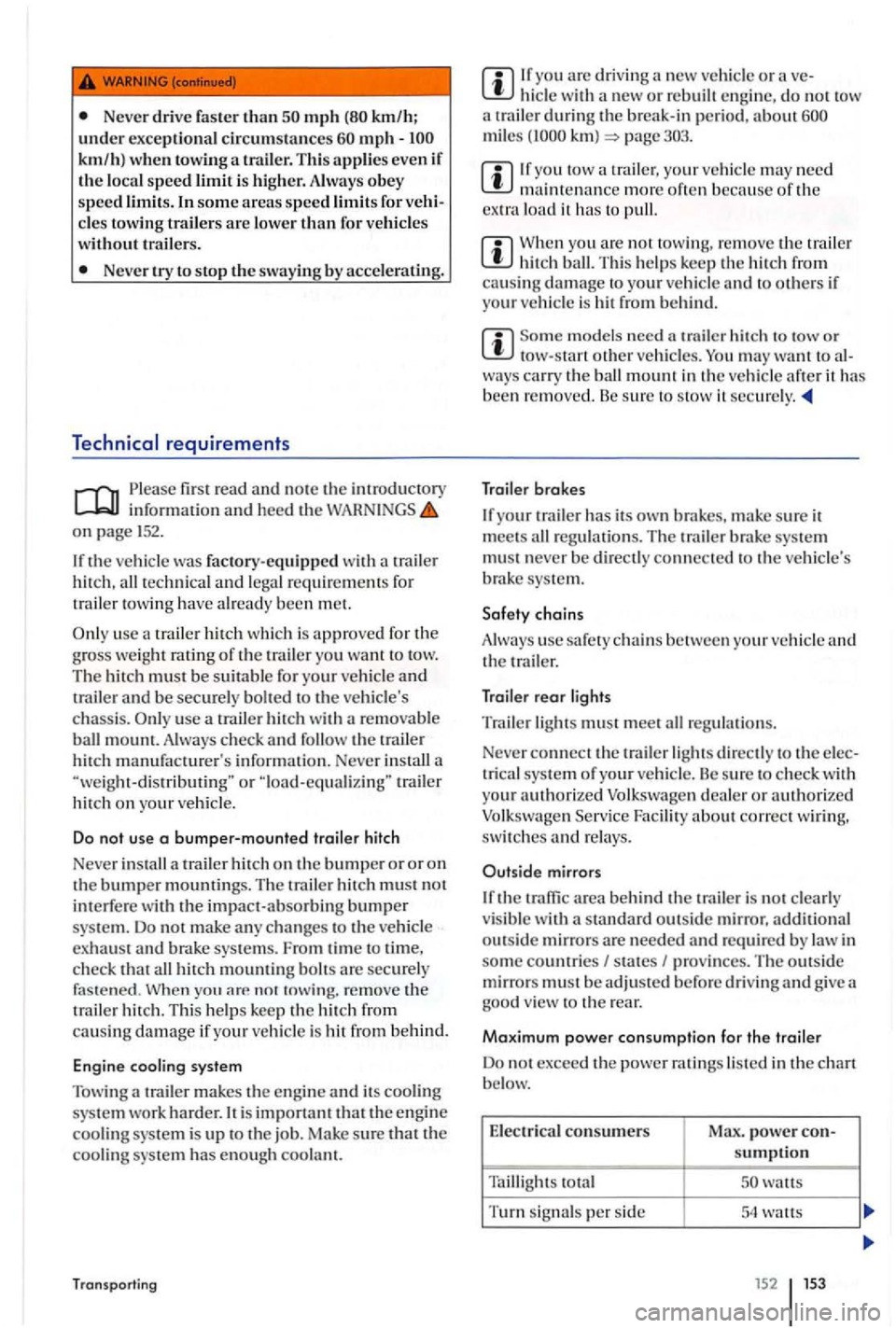
Never drive fa ster than mph mph -
Never try to stop the swaying by accelerating.
fir st read a nd note the imroductory informatio n and heed the on page
If the ve hicle was fac tory-equipped with a trail er
hi tch, all technical and lega l require m em s fo r
trailer towi ng have already been m et.
use a trai le r hitc h w hich is approve d for the
g ro ss wei ght rating of the trailer yo u want to tow. The hit ch mus t be s uitabl e fo r your vehicle and
tr ailer and be securely bolt ed to the ve hicle's chassis. use a trail er hitc h with a re movable ball mount. Alway s check and follow the trail er
hi tch manufacturer's information. Neve r in stall a o r tra ile r hitch on yo u r vehicle.
D o n
ot use a bumper-mounted trai le r h itch
Never insta
ll a trailer hitch on the bumper o r or on th e bumper mountings. The traile r hit ch mus t not in terfe re wit h the impact-absorbing bumper syste m . D o not make any changes to the ve hicl e exhaust and brake sys te m s. From time to time, check that all hitch m oumin g bolts are securely fas ten ed . W hen not towing. re m ove the trailer hi tch. Thi s help s ke ep the hitch from causin g damage if your ve hicl e is hit from behind.
Eng ine cooling syste m
Tow ing a tra
iler makes the e ngin e
If you arc dri ving a new ve hicle or ave-do not tow
a t railer
mil es
need
load it h as to pull.
When you are not towin g, remove the trailer
models need trail er hit ch to tow or tow -s tart other ve hicl es. may
Trailer brakes
If your trail er has its own brake s, make sure it
meet s all regulati ons. Th e trailer bmke sys te m
mu st never be directly connecte d to the ve hicle's brake system .
Safety c
hain s
A lways u
se safety chains be tween yo ur vehicle and
th e trailer.
Trail er rear lights
Tra
ile r lights must meet all regulation s.
Neve r
connect the tmil er l ights directly to the e lec
trica l s ys tem of your ve hicl e. Be su re to check wit h
your authorized Volkswagen dealer or authorized Volk swagen Faci lit y about correct w iring, sw itches and re lay s.
Outside mirrors
I f
the s ta ndard ou ts id e mirror, addition al outs ide m irrors are needed and required b y law in so me coumrie s I states I provin ces. The o uts id e
mirr o rs mus t b e adjuste d b efore driv in g and g ive good v iew to the rear.
Max im um power consump tio n f or th e trailer
D o no t excee d the power ratin gs liste d in the chart below.
E l
ectrical consumers power con-sumptio n
Taillight s
Turn signals pe r sid e 54 wat ts
Page 157 of 541
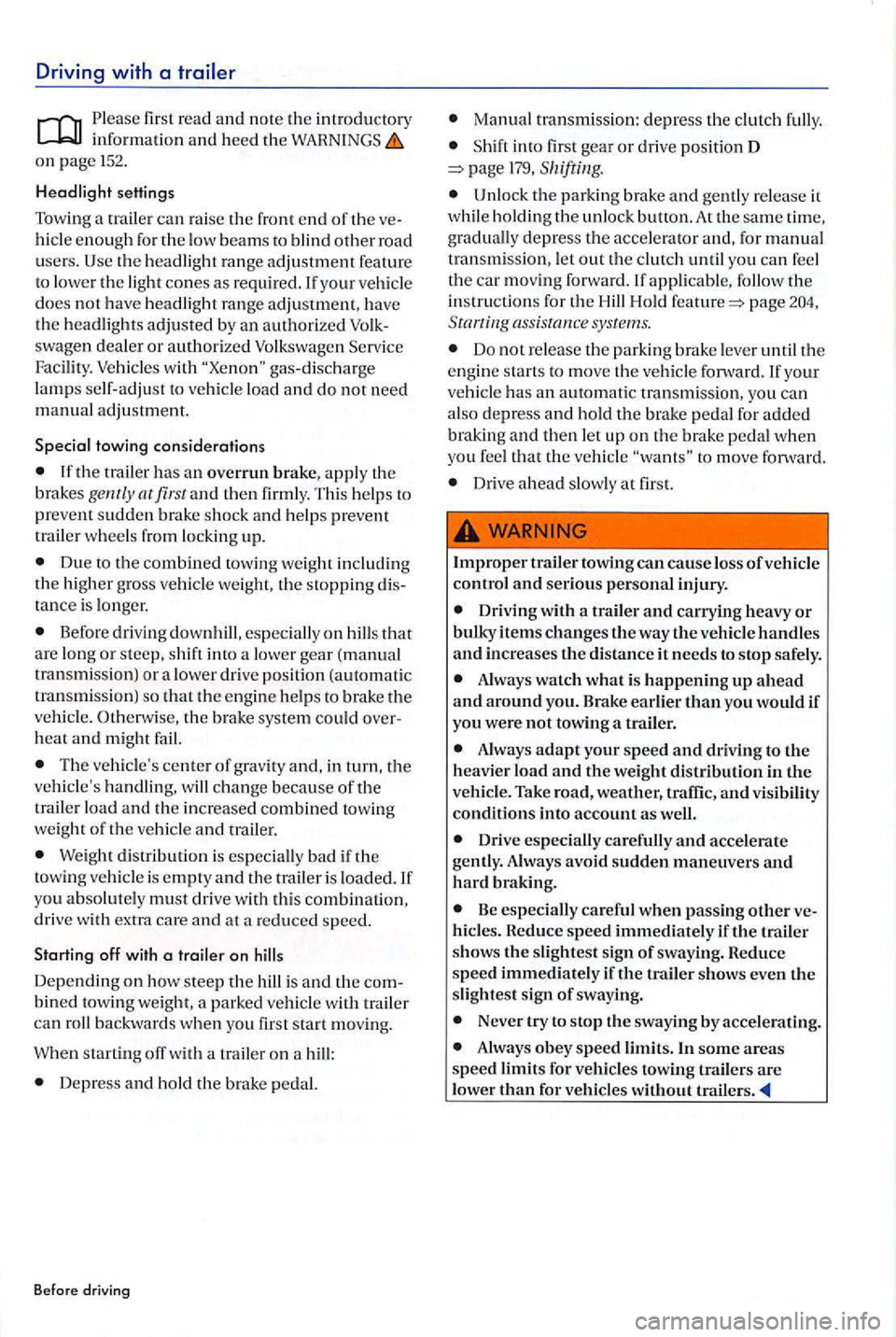
Driving with a
Please fir st read and note the introductory
o n page 152.
Headlight settings
Towing a tra
ile r can ra ise the fron t end of th e ve
hicle enough fo r the low beam s to blind other road u sers. the headlight ra nge adjustment feature
to lower the light cones as req uired . your vehicle does not have headlight range adjustment, have
the headli gh ts adjusted by an authorized Volkswage n dealer or au th orized Volkswagen Serv ice Facility . Vehicles with gas-d ischa rge lamps self-adjus t to vehicle load an d do not need manual adjustme nt.
Special towing
considerations
Due to th e combined towing weig h t includin g the hi gh er gross vehicle weight, the stopping distance is longer .
Before driving downhill , especially on hills that
a re long or steep, shift in to a lower gea r (m anual
t ransmi ssion) or a lower drive position (automatic
t ra n smi ssion) so that the eng in e helps to brake th e vehicl e. Otherwise, the b rake system could ove rheat and might fail.
The ve hicle's center of grav ity and, i n
Weigh t dis tr ibutio n i s especially bad if the
tow ing veh icle is e mpty and the traile r i s loaded. If
you absolutely must d rive with this combination , drive with extra care an d at a reduced speed.
Starting off with a trail er on hills
Depend ing o n how steep the h ill is and the combined tow ing weig ht, a parked vehicle wi th trailer can roll backwards when yo u firs t sta rt mov ing.
When sta rti
ng off with a trailer on a hill :
Depress and ho ld the brake pedal.
Befo re driv ing
Ma nual transmiss io n : d epress th e clutch fully.
Shift into fir s t gear or drive posi t ion D page 179,
Unlock the par ki ng brake and release it
w hil e ho ld ing th e unl ock butto n.
page assistance systems.
Do not re lease th e parkin g bra ke leve r until the engine sta rt s to move th e vehicle fonvard. your veh icle has an automatic t ransmissio n, yo u can
also depress a nd ho ld the brake pedal for added b raking and then letup on th e brake pedal w hen
you feel th a t the vehicle to move fo rward.
Drive ahead slowly at first.
A lways watch what i s happening up a head
and a round you. Brake earlier than you would if yo u were not to wing a trailer.
Drive especially care full y and accel erate gently. Always avoid sudde n m an euvers and h ard braking.
Be especiall y care ful when p ass ing other hicles. Reduce speed immediate ly if t he trailer
s hows the s lightes t sig n of swayin g. Reduce speed immediatel y if the t ra ile r shows even the
slightest sig n of sway ing.
Neve r try to sto p th e swayin g by accelerating.
Page 190 of 541

Note
Always be careful when you park in areas with parking barriers or high cmbs. These vary in h eigh t and could damage your bumper andrelated parts ifLhe front of your ve hicl e hit s a barrier or curb that is too high while you are getting into or out of a parking spot . To help prevent damage, stop before the tires of your vehicle touch a parking barrier or curb.
Warning and indicator
Note (continu ed)
Always be careful when you enter a driveway or drive up or down steep ramps or over curbs or obstacles. of the vehicle close to Lhe ground may be damaged (s u ch as bumper covers,
spoilers, and parts of the engine, suspen sion, and exhaust
firs t read and note Lhe introdu ctory informat io n and hee d the WAHNINGS page 188.
Lig ht s
191.
Brak e syste m malfun ction. Stop!
Get
expert assi stance pag e 192.
Brake fluid leve l too low. Stop!
BRAKE brake fluid page 197.
Take the vehicle to an au thorized indicator light or dea ler or authorize d Volksw agen Service Fa-
ABS: failure. ci
lity. Th e ve hicl e brakes will work without ABS.
Brake pedal not depressed! Depress the brake
pedal.
BRAKE Immediate ly take the vehicle to an auth orized
WEAR Front brake pads wo rn. Volkswagen dealer or authorized Volk swage n
Serv ice Facility. and if necessary re-place, all brake pads.
switc h ed off for syste m r easo ns. Switch ignit ion off an d on again . You may have
to dri ve a short dis tan ce.
Take th e ve hicle to an authori zed Volksw age n malfunc ti on. dealer or a
uthorize d Volk sw agen Service Fa-cilit y .
Tak e the vehicl e to or d ea le r or a uthori zed Volksw agen Service Fa-
ABS:
page257
manually deacti va te d. S
witch on p age 196. a ut om atically
turns on w he n you turn the ig nition on and off.
Startin g, shift ing, parking 188 189
Page 191 of 541

Lights cause or up
I
Together w ith indicator
m alfun ction.
T oge th
er with warning light
cause
or is opera ting.
W hen the ig nition
is sw itched on,
light s and instrument cluster text messages can cause the vehicl e to
break down in traffic and result in a collision and serious personal injury.
Never ignore warning light s or text WARN
Always stop the vehicl e as soon as it is safe to
do so.
Driving
with bad brake s can cause a collision and serious p ersonal injury .
does
not go out, or co mes on w hen driving, either the brak e fluid leve l in the reservoir is too low or there is a fault in the brake sys tem. Immediately
s top driving and get expert assista nce
response
Take the veh icle to an authori zed Volkswage n
d ealer or authori zed Volkswagen Service Fa-The ve hicl e brake s will work without
response
foot off accelerator pedal. Adapt driving to road conditi ons.
If the brake warnin g light BRAKE or co mes on at the same time as the warning light or th eABS may not be working properly. Thi s
could cause th e rear whee ls to lock up re latively
quickly during braking. Rear wheel brake lock
u p can cause loss of veh icle control. If yo u be
lieve that it is safe to do so, reduce your speed and d ri ve carefully and at low speeds to the neares t authorized Volkswagen dealer or a qual
the indicator light or does not go out , or if it comes on driving, the sys tem is not workin g properly. The vehicle can th en be stopped onl y with the standard brake s
(wi thout ABS). w ill not have the protection provides. Contact your authorized Volk
swage n dealer or an authorized Volkswagen vice Facility as soon as possib le.
lights up in the
in strument cluster display, whether alo ne or to gether with a te xt message, immediately contact an authorized Volkswagen dealer or authorized Volkswage n Facility to have the brake pad s ch ecked and, if necessary, replaced.
Note
Failure to heed warning lights or text WARNINGS can re sult in vehicle damage